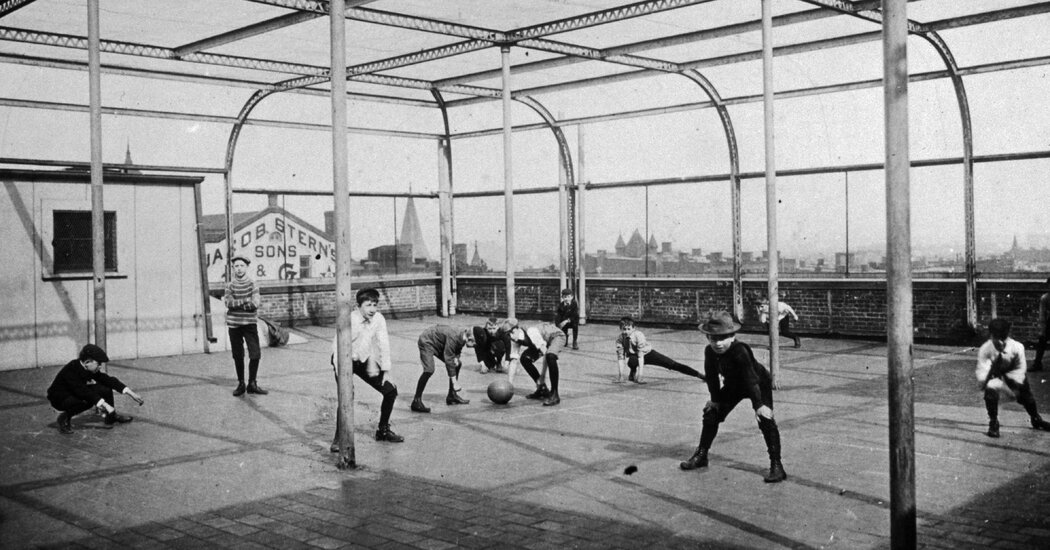A parent could be forgiven for thinking that adolescents are primitive. They speak in monosyllables (“Food!”), if they speak at all. Their cognition can described as dim. (“Where are my shoes!? Oh, they’re on my feet.”) As a group, they seem to be not merely not-yet-mature-humans but not-yet-fully-humans-at-all — Homo habilis maybe, Neanderthals at best.
Take heart in this impression. A century ago, when adolescent psychology first emerged as a field of study, that was exactly the thinking: Teenagers are literally not fully evolved; they are pre-human.
The main proponent of this idea was G. Stanley Hall, a psychologist and educator at Clark University who in 1878 had received, from Harvard, the first doctorate in psychology awarded in the United States. At the time, adolescence was not just a mystery but a nonentity. For centuries leading up to the Industrial Age, young humans went directly from childhood into the work force and reproductive mode. The economy permitted no room for semi-productive adolescents, much less anything like teen culture.
There had been echoes of teen angst. William Shakespeare’s “Romeo and Juliet” appeared in 1597. “The Sorrows of Young Werther,” the 1774 novel by Johann Wolfgang von Goethe, tells the story of a young man who, in pursuit of love, navigates melancholy, euphoria, suicidal ideation and, eventually, unrequited feelings that end in tragedy. The book was part of a late-18th-century German literary movement known as Sturm and Drang, which identified tumult and stress as defining characteristics of impulsive, romantic young people.
Hall, born in Massachusetts in 1844, came of age amid major social and demographic change. With improvements in medicine, sanitation and living conditions, the life span of the average American was increasing, from roughly 40 in 1800 to near 50 by 1900. Progressive reformers sought to combat the ills of industrialization and called for compulsory elementary education; gradually, more working-class families opted for high school, because more learning could lead to better wages.
These forces combined to wedge a new time period between childhood and adulthood. Hall was among the first scholars to try to name and explain it.
“Up until Hall, there was an amorphous general notion that there was this period of life that was different,” said Dr. Laurence Steinberg, a psychologist at Temple University and expert on adolescence. “What Hall did was connect the dots. He was the first person to put it all together.” He added, “He had some ideas that were wacky and some that were brilliant.”
Today, we understand adolescence as a phase of intense cognitive and social development. Young people are working intensely to integrate the known (what they learn from parents, prior generations and classrooms) and the unknown — namely, what they discover as they experiment in the world and forge new ground. This transition process generates conflict, both external and internal, as adolescents try to adhere to learned rules while adapting to change, all with a brain dialed in to seek reward.
Viewed this way, adolescents are highly sensitized, clumsy, advance scouts on the frontier of ideas, pointing toward and molding the future. When Dr. Hall looked around, and at existing science, he was troubled. He noted rising crime rates among adolescents: In 1890, there were 58 juvenile reformatories in the United States, typically holding people ages 5 to 25, with an average age of 14.23. With less evidence, he associated the boredom that adolescents sometimes exhibited with a tendency to become vagabonds and hobos. He described various studies from the prior two decades, including one suggesting a relationship between puberty and nervous disorders.
His observations and concerns came against a backdrop of mass immigration into the United States. Distinctions were being drawn between “civilized” Americans and less civilized newcomers. Cities were bursting and, as Hall saw it, filled with temptation and vice. To him, adolescents were a linchpin in a messy society that could either progress or regress — and they displayed alarmingly backward tendencies.
“Every step of the way is strewn with the wreckage of body, mind and morals,” he wrote in his seminal 1904 work, “Adolescence: Its Psychology and Its Relation to Physiology, Anthropology, Sociology, Sex, Crime, Religion, and Education.” “There is not only arrest, but perversion, at every stage, and hoodlumism, juvenile crime, and secret vice.” (By “secret vice,” Hall meant masturbation.)
But why would such a life period exist? Hall’s explanation for these behaviors was straightforward and in sync with scientific thinking of the period: Adolescents were replaying a primal stage of human evolution.
In the late 1800s, with the improvement of microscopes and the advent of Charles Darwin’s theory of evolution by natural selection, biologists had begun taking a closer look at how the embryos of different species developed over time. To all appearances, the embryos of more “advanced” species, notably humans, resembled, at various stages, the embryos of “primitive” or ancestral species — fish, salamanders, chicks, hogs, rabbits. It was as if the developmental growth, or ontogeny, of an organism manifested the evolutionary history, or phylogeny, of the species. The idea became known as recapitulation theory and was summed up by Ernst Haeckel, a German embryologist, in a clunky phrase: “ontogeny recapitulates phylogeny.”
All around him, Hall saw evidence that a similar pattern was playing out as humans grew to adulthood, seemingly recapitulating the evolution from apes to Homo sapiens. Very young children were understandably simple and selfish. “Infants are helpless because that’s how the species started out,” Dr. Steinberg said, summarizing Hall’s perspective.
Then came the adolescent, which Hall described as “neo-atavistic” and “suggestive of some ancient period of storm and stress.” It wasn’t all their fault: As we blame smartphones today, Hall blamed the lure of the urban environment. “Never has youth been exposed to such dangers of both perversion and arrest as in our own land and day,” he wrote in 1904.
For this reason, Hall felt that young children should be rigorously educated, before the unavoidable, chaotic teen years set in.
“Never again will there be such susceptibility to drill and discipline, such plasticity to habituation, or such ready adjustment to new conditions,” he wrote. “It is the age of external and mechanical training. Reading, writing, drawing, musical teaching, foreign tongues and their pronunciation, the manipulation of numbers and of geometric elements, and many kinds of skill have now their golden hour.”
To safely navigate adolescence, he went on, it was vital that teens continued in a structured environment, like a rigorous high school, in order to complete their literal evolution to adulthood. “We are conquering nature,” he wrote. “Adolescence is a new birth, for the higher and completely human traits are now born.”
Hall also laid the groundwork for important ideas that have stuck, like the plasticity of adolescent minds. He even alluded to the value of breathing techniques in calming anxiety, an idea that is only now in fashion.
But the idea that adolescence marked a primitive stage of humankind didn’t last long in the scholarship. Other researchers soon took over — Anna Freud, Erik Erikson and others who increasingly saw adolescents as individuals working through conflict.
More recently, the scholarship has married the behavioral observations of these pioneers with more empirical evidence drawn from neuroscience, biology and other fields. What has emerged is an understanding that adolescents inhabit a period of intense sensitivity to the world around them. What looks like boorish behavior to adults can actually represent the act of putting conventional wisdom to the test. Likewise, anxiety and depression may indicate a kind of information overload — the adolescent’s processing system is stymied and frustrated by the onslaught of ideas, many delivered by electronic devices, in a fast-moving world.
Adolescents aren’t backward at all: They are grappling with how to look forward, and they are molding us as much as we are molding them. Neanderthals? Only in the occasional odor. But don’t hesitate to ask them to use a fork, finish their homework and put down the smartphone long enough to bathe.
Matt Richtel is a health and science reporter for The Times, based in Boulder, Colo.
The post A Century Ago, Adolescents Weren’t Fully Human appeared first on New York Times.




